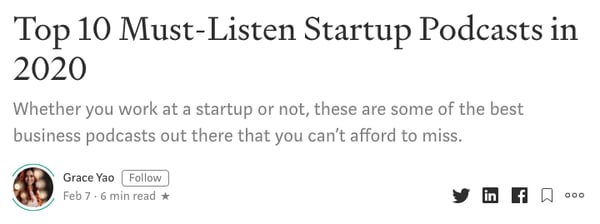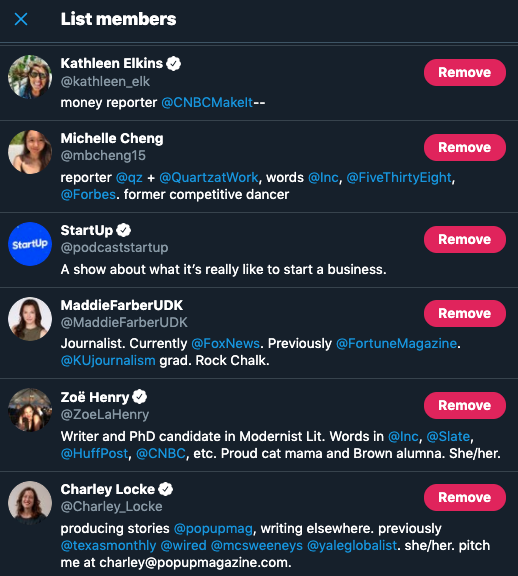Stop Spamming Reporters: Here's How to Build and Grow a Media List for Your Startup

The dirty little secret of PR is that much of what firms like Propllr get paid for can be done by anyone. Probably not as well and almost certainly not with as much speed, creativity, or consistency. But still, it’s doable.
(In fact, most of the Propllr blog is focused on showing you how to do what we do, including this post on DIY PR.)
Among the bread and butter of startup PR tactics is the building and maintenance of a media list.
What Is a Media List?
First, let me tell you what a media list isn’t.
It isn’t an aging and inaccurate Excel spreadsheet of over 500 people who you spam whenever you think you have something worth sharing.
A media list is a collection of reporters, editors, bloggers, freelancers, and podcast hosts whose prior work suggests they are (or should be) interested in you, your company, your product (or service), and your insights.
Think of it as a list of your top sales prospects. These are professionals who deserve respect and with whom you want to build relationships over time.
How to Start a Media List
The good news is that you don’t need to pay for any expensive media databases or media list-building tools.
Better yet, the first step to building a media list is to think small. Begin with a target list of about 10 names across a few categories: local, industry trade, small business, and startup / VC.
Now you just need a few names from each category to reach your goal.
Building a Local Media List
For local media lists, you’ll want to have a contact from the daily newspaper, the weekly business journal, and any local startup outlets. But don’t just email the business editor at your paper. Do some research to find exactly the right person.
For example, you can search your local newspaper’s site for the word “startup” to see who is writing about the local scene. (Warning: Publisher search functionality is generally terrible, and newspapers are the worst offenders).
Or you can search your local business journal for well-known local startups to see which reporter has most recently covered the space.
Or if your startup focuses on a particular industry – e.g., food, education, healthcare, etc. – you can find the reporter who covers that beat by searching the publication’s “contact us” section.
Lastly, more and more cities have media outlets focused on their startup scenes. Be sure to add those publications to your list. A popular outlet that's broadening its coverage around the U.S. is American Inno. It's now in 14 cities, including Chicago, Austin, and Minneapolis. We love the team there.
Building a Product or Industry Trade Media List
Now, turn your attention to outlets covering your industry or product category. As with the local list, the initial goal here is to identify just a handful of outlets.
Let's say you are a B2B SaaS company serving a particular industry. You probably already know which magazines people in your industry read, so start there.
If you don’t know those publications, you can run Google searches for “Top [Industry] Magazines” and “Top [Industry] Websites.” Look for the three to five outlets that keep appearing on every list. Or if you have a friendly client, you can ask them what they read.
Similarly, if you’re a B2C product company, I'd guess you know the outlets popular with your customers. But if not, try Googling “Best Blogs for [Category]” or “Best Websites for [Category].”
Building a Startup Media List
Next, build a media list of national outlets covering startups and growth companies.
The 800-pound gorilla of this list is TechCrunch, of course, but others include Inc., Entrepreneur, Business Insider, Forbes, SmallBizDaily, not to mention countless blogs.
Word of advice about TechCrunch. They rarely cover very early stage startups, and really never do unless there’s some sort of hard news (i.e., funding). So when you reach out to them, it’s all about planting seeds for later, when you do have news to share.
Ironically, finding the right startup reporter at a startup-focused outlet can be more difficult than at a general interest publication. Try finding a way in by searching for reporters who have already covered your space or your competitors. For example:
- If you're a B2B SaaS startup, find a reporter who has written about other SaaS companies.
- If you’re a real estate tech startup taking on Airbnb, find the reporter who knows Airbnb the best.
- If you’re a bootstrapped startup, find the one who has written about other bootstrapped companies.
Building a Podcast Media List
Podcasts are awesome new media outlets for startups. Listenership is often limited, but every single subscriber has opted in and they are very highly engaged while listening.
In general, as long as a podcast is well-produced and reaches the right audience, we highly recommend building relationships with them. (To get started, here’s our write-up on how to pitch podcasts).

It’s pretty simple to find podcasts for your media list (Google “Top podcasts for [TOPIC]”, but you’ll want to be sure you take the time to listen and really get to know one before reaching out.
Is it produced well? Is the host good at interviewing? Are the topics and tone correct for you? Is the discussion beneath or beyond you? Are you a fit for their typical guest?
If all of the above check out, add it to the list.
How to Find Reporter Emails
So you have a list of 10+ reporters and media contacts. How do you get their emails? (You don't need phone numbers – they'll never pick up.)
Thankfully, reporter emails are pretty easy to find.
First, check their author page by clicking their name where it appears under a headline. That will take you to a page that has a brief bio and a list of all of their stories. The bio often has the reporter email address readily available. Here's an example:
 If it’s not there, check the publication’s contact page, which you might have visited when finding some of the reporters on your media list. (This is normally linked to in the footer).
If it’s not there, check the publication’s contact page, which you might have visited when finding some of the reporters on your media list. (This is normally linked to in the footer).
If you don’t see the reporter's email there, you should be able to see non-editorial staff email addresses, so just try copying their email format (i.e., firstname.lastname@outlet.com). You’ll probably get through. This is a pretty standard publication footer menu:
 Another place reporter emails can be found is in Twitter bios, like this one:
Another place reporter emails can be found is in Twitter bios, like this one:
 If none of those strategies work, try an email look-up service, like LeadBoxer or Hunter.
If none of those strategies work, try an email look-up service, like LeadBoxer or Hunter.
You Have Your Media List. Now What?
Step 1: Set It Up to Grow Automatically
Your media list should always be growing, and thankfully, you can turn to Google for that service. Create Google News alerts for the following:
- Competitor mentions
- Relevant keywords
- Headlines you’d want to be in
Not every article you see from the above search will be by a reporter who deserves to be on your media list, but having alerts should capture all of the ones that should.
You’ll have a lot of false positives, like when a competitor may have been written about but not for a reason that suggests the writer would also do a piece on your startup. And no doubt, these alerts won’t catch some good targets, but there’s no easier or cheaper way to build your list.
Step 2: Start Building Relationships
The R in PR stands for Relationships, and the best time to get started building relationships is right now, because they take time.
Like any new relationship, hold off on telling your life story. Just say “hi” before trying to get to “buy.”
Here’s a sample template you can use when you read an article that makes you think you could be a good source for its writer.
Caution: DO NOT TURN THIS INTO A MAIL MERGE. I'm sharing this as an example and only to make it easier and faster to act when you discover a reporter who you think could actually benefit from connecting with you:
[FIRST NAME],
I just read your piece about [TOPIC] and had to get in touch.
I’m the founder of [STARTUP], a new [CATEGORY] startup that [PROBLEM SOLVED].
Regarding [TOPIC], we do a lot of work in that area, and I think it could make me a really good source for you if you revisit it later. One of the most interesting things happening, IMO, is [UNDER THE RADAR TREND].
I hope we can connect more formally at some point, and I look forward to reading more of your coverage.
[YOUR NAME]
Step 3: Create a Private Twitter List
Twitter is a great platform for building real and authentic relationships with reporters – not just based on what they cover but on who they are and what they’re passionate about.
Since most reporters are on Twitter, create a private Twitter list made up of your media list members in order to stay on top of what they’re writing and sharing. Then, check the list once or twice a day.
When they post something you genuinely connect with in some way, respond with a favorite, a retweet, or a reply.
 Step 4: Bookmark Reporters’ Author Pages
Step 4: Bookmark Reporters’ Author Pages
Bookmark each reporter’s page in your browser and make a point of clicking through it every few days.
Then, when you see an article that speaks to you in some authentic way, reach out to let the reporter know, and share your thoughts about it on Twitter.
Maybe it was about something you didn’t know, maybe you loved reading it, or maybe you vehemently disagree with something in it – whatever your take, be sure to tag the reporter, not the publication, in the tweet.
Step 5: Keep Track of Your Outreach
Find a system that can accurately track all of the outreach you’re doing as you build these relationships. The one we use to manage all of our clients’ PR pipelines is Streak: it makes it easy to build infinitely customizable email-driven pipelines and it’s built right within Gmail.
Why is Streak so great for this?
- It aggregates all emails sent to each reporter, even if they’re not part of an email chain.
- It provides a quick view into when emails went out, a useful reminder for when you should check in again.
- It gives easy access to the text of pitches that worked best.
My Final Word of Advice on Building a Media List for Your Startup
The best relationships are real. Reporters can sniff out phony opportunists.
So be ...
Respect their work. Respect their time. Learn from them. Give to them freely without expectation of return. Share your advice, your insights, your experiences. The rest will follow.
And for God’s sake, protect their jobs by subscribing to their publications if you can.
Onward and Upward!







